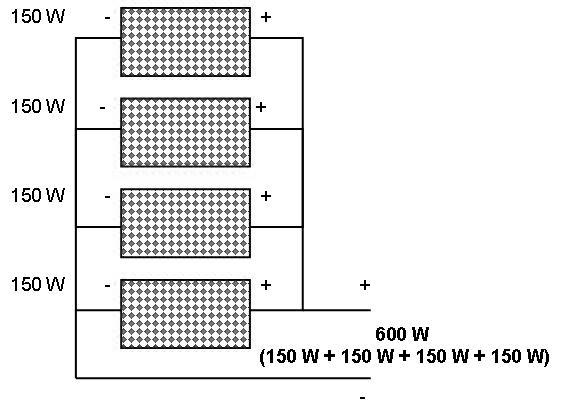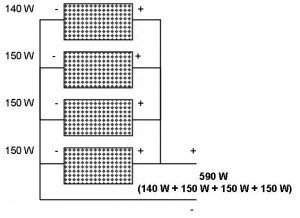Selecting and connecting solar panels of assorted voltage or wattage in series and parallel configurations, and manufactured by different suppliers is generally a sought after question by most DIYers.
Even though connecting several solar panels is not encouraged, it’s not prohibited either and everything could well be fine provided that each panel’s electrical criteria (voltage, wattage, amps) are cautiously evaluated.
Should you wish to connect two solar panels manufactured by different companies in series or parallel configurations, the manufacturers are generally not the issue.
The issue remains in the conflicting electrical attributes of the solar panels, as well as their unique efficiency ratings.
If Photovoltaic devices are hooked up in series to accomplish increased output voltage. The optimum system voltage however should not be surpassed.
For devices attached in series total power is determined as given below:
Connecting solar panels in series

Absolute interconnected power = 150W + 150W + 150W + 150W = 600W
Having said that when panels are attached in series, one of the panel may carry a rated power below the other panel, because of the lower current spec of this solar panel with respect to the other modules in the chain, that unit could tend to drag down the existing system's output:
Combining different solar panels in series

Solar devices are normally attached in parallel to achieve greater output current.
For Photo voltaic components attached in parallel absolute power is determined as cited below:
Connecting solar panels in parallel

Add up to combined power = 150W + 150W + 150W + 150W = 600W
Contrary to the combination in series, when solar panels are connected in parallel there may be one panel having power output below the spec of the other devices, this could perhaps not influence the total power output of the chain significantly only if this particular panel possesses voltage rating on par with the other modules voltage:
Connecting different solar panels in parallel

Optimum voltage on a series of modules should invariably be less than highest input DC voltage of the inverter.
While hooking up diverse solar modules, it’s not the different power specifications that might be crucial, rather it’s basically the current (for series connection) and voltage (for parallel connection) that might cause the draw down of the efficiency of the system.
Typically solar panels of specific or matching current needs to be connected with each other in series.
Should you connect a 3A solar panel to a 3.5A solar panel, the all round current will probably be pulled down to 3A.
This kind of a lowering of current would of course cause a loss of power output and eventually loss in equipment efficiency.
In the same way only solar panels of specific or matching voltage must be connected with each other in parallel.
Whenever you hook up a 15V panel to a 24 V panel, the overall voltage is going to be pulled down to 15 Volts. This kind of a lowering voltage will probably lead to a decrease in power output, and eventually deterioration in system efficiency.
In comparison to voltage and current, watt is not a major issue. Whenever you connect with each other a 60W solar panel to a 100W panel in series, the gross hooked up power is likely to be 160W, given that the two solar panels are of identical ampere rating.
At this point any specific difference in voltages is not crucial, voltages would simply add up and all you’ve might need to judge is the fact that the total voltage must come within the inverter voltage limit.
In case their current specs are not the same , just be willing to witness undesirable consequences, because the overall current could possibly be the lower of the two panel specifications, which usually shows that you’re not gonna accomplish a maximum of 160W rather often way less. Just how much less - is relative to dissimilarity in specified currents.
Additionally if you connect collectively a 60W solar panels to a 100W panel in parallel, the absolute associated power is likely to be 160W, assuming that the two solar panels are of matching voltage.
Here any kind of difference in currents is not crucial, currents wouls simply add up and all you’ve need to take into account is that the absolute current must not extend past the highest inverter input current.
When their voltage specifications are not the same , you need to be ready to expect disagreeable situations, because the overall voltage could possibly be much lower than the individual units, that could imply that you’re not likely to accomplish an overall of 160W rather consistently less.
Just how much less - boils down to the difference between the voltage rating of the two.
you delt only with watts parallel is the same voltage serial increase voltage
a necessary number to avoid overloading the charge controller some can only handle specific voltage as well as watts
Will 2 strings of 2 panels each in series-parallel also share the shade characteristics, so that the two strings won’t be affected by each other, but the 2 panels in each string will affect one another?
Sorry, I am not sure about it…